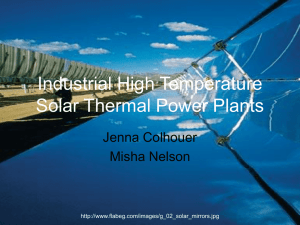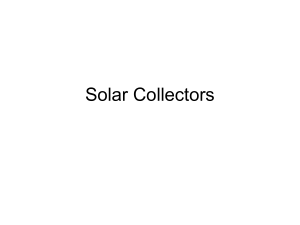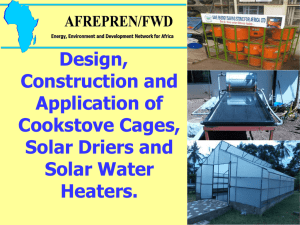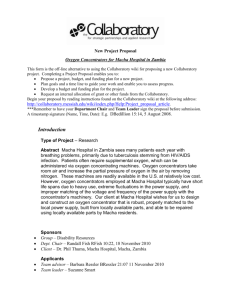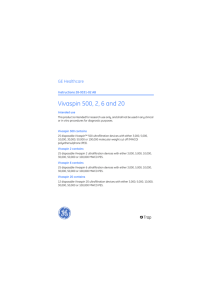Use of Solar Energy for Industrial Applications:
advertisement
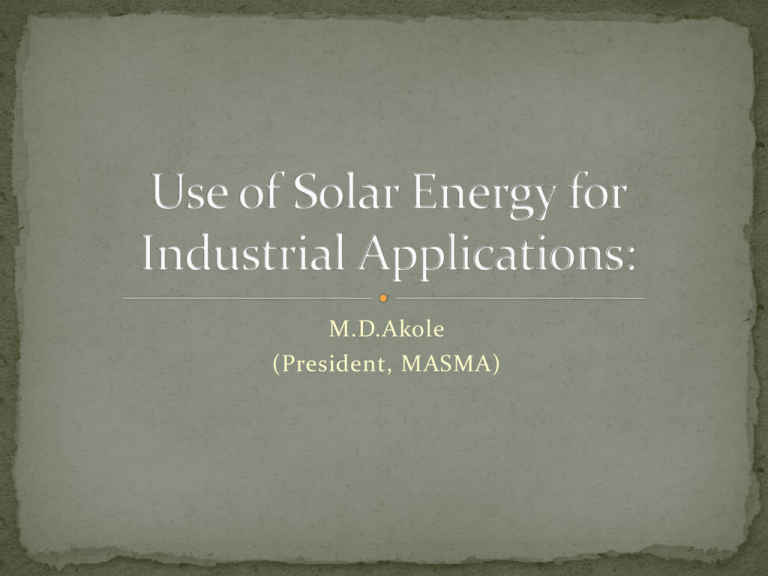
M.D.Akole (President, MASMA) • The total solar energy absorbed by Earth's atmosphere, oceans and land masses is approximately 3,850,000 exajoules (EJ) per year. In 2002, this was more energy in one hour than the world used in one year. • Photosynthesis captures approximately 3,000 EJ per year in biomass. • The amount of solar energy reaching the surface of the planet is so vast that in one year it is about twice as much as will ever be obtained from all of the Earth's nonrenewable resources of coal, oil, natural gas, and mined uranium combined. Industrial requirements can be categorised into two broad streams: Thermal requirements: These include all the process heating applications in industries like electroplating, coating, dairy, pharmaceutical, paint-shops etc. Electrical requirements: These can include all lighting loads in the common areas, street lighting, office equipments etc. Solar Thermal systems are systems which convert Solar Energy into Thermal Energy. Solar Concentrators are devices which concentrate the energy falling over a large surface onto a smaller surface. This leads to higher temperatures which can be used for a range of applications. Solar Thermal systems can be broadly classified as: The low temperature systems are systems which operate from room temperature to 80-85 degree centigrade. These include systems for : Boiler feed pre-heating, drying, heating of chemical baths, textiles etc. The basic solar device used for these systems are the water heating collectors, namely the Flat Plate Collector and the Evacuated Tube Collector. Drying systems utilise the Air-heating collectors. Drying systems can also be used for Effluent Evaporation. These processes are carried out from 90/95 upto 200 degree centigrade. These include: A. Chemical industries. B. Dairy applications. C. Textile industries. D. Pharmaceutical industries. E. Food processing. F. Cooling requirements (VAM based air-conditioning) to name a few. These temperature requirements can be met with the use of Solar Concentrators. Solar Concentrators are devices through which high concentration of the Sun’s rays is achieved resulting in high temperatures. Solar Concentrators are also categorised as medium temperature concentrators and high temperature concentrators. Medium Temperature concentrators are concentrators that are best suited for applications in the medium temperature range. e.g. Scheffler Concentrator. Scheffler Concentrator is an Unique Concentrator which has a fixed focus and which tracks independent of the receiver. Temperature range: Suitable for applications upto 160180 degree centigrade. Ideal Applications: All processes which have requirements of temperature and pressure upto 180 degree centigrade and 10 kg/cm2. “Solar Kitchen” is a very popular application of the Scheffler Concentrator. Industrial canteens consume a large quantity of LPG for cooking. These can be converted to “Solar Kitchens” thus reducing the LPG consumption upto 50%. These applications lie in the range of 200-450 degree centigrade. The concentrators required for these applications are the Parabolic Trough Collectors (PTC’s) and the ARUN paraboloid dish. These Concentrators are capable of producing very high temperatures and pressures and are best suited to cater to this segment. Abundant and free source of energy. Completely non-polluting and clean source. Best suited for industrial applications amongst all renewable energies. Ever increasing costs of fuel. Ever increasing pollution due to combustion of fossil fuels. Solar energy equipment can be easily incorporated in the existing process. Existing heating system can be used as backup for inclement weather conditions. Medium temperature applications: 20 million tonnes of oil/year saved = Rs. 80K crore/year. High temperature applications: 35 million tonnes of oil/year saved = Rs. 140K crore/year. 80% accelerated depreciation in the first year. Capital Subsidy @ 30%. Green image for the organisation. Fuel savings provide an edge over competion. The approximate payback periods for the different systems are as follows: Low temperature: 1.5-2 years. Medium temperature: 2.5-3.5 years. High temperature: 3.5-5 years. Proven indigenous technology. Answer to ever-increasing fuel bills. Pollution free, clean source of energy. Abundantly available. Easy to operate systems. Low on maintenance. Attractive payback. Thank You!!!


